
Bretton Hall is a country house in West Bretton near Wakefield, West Yorkshire, England. It housed Bretton Hall College from 1949 until 2001 and was a campus of the University of Leeds (2001–2007). It is a Grade II* listed building.

Pontefract is a historic market town in the Metropolitan Borough of Wakefield in West Yorkshire, England, east of Wakefield and south of Castleford. Historically part of the West Riding of Yorkshire, it is one of the towns in the City of Wakefield District and had a population of 30,881 at the 2011 Census. Pontefract's motto is Post mortem patris pro filio, Latin for "After the death of the father, support the son", a reference to the town's Royalist sympathies in the English Civil War.

Featherstone is a town and civil parish in the City of Wakefield, West Yorkshire, England, two miles south-west of Pontefract. Historically part of the West Riding of Yorkshire, in 2011 it had a population of 15,244. Featherstone railway station is on the Pontefract Line.
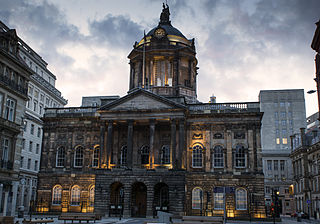
Liverpool Town Hall stands in High Street at its junction with Dale Street, Castle Street, and Water Street in Liverpool, Merseyside, England. It is recorded in the National Heritage List for England as a designated Grade I listed building, and described in the list as "one of the finest surviving 18th-century town halls". The authors of the Buildings of England series refer to its "magnificent scale", and consider it to be "probably the grandest ...suite of civic rooms in the country", and "an outstanding and complete example of late Georgian decoration".

Tabley House is an English country house in Tabley Inferior, some 3 kilometres (1.9 mi) to the west of the town of Knutsford, Cheshire. The house is recorded in the National Heritage List for England as a designated Grade I listed building. It was built between 1761 and 1769 for Sir Peter Byrne Leicester, to replace the nearby Tabley Old Hall, and was designed by John Carr. The Tabley House Collection exists as a permanent exhibition showcased by the University of Manchester.

The Sydney Town Hall is a late 19th-century heritage-listed town hall building in the city of Sydney, the capital city of New South Wales, Australia, housing the chambers of the Lord Mayor of Sydney, council offices, and venues for meetings and functions. It is located at 483 George Street, in the Sydney central business district opposite the Queen Victoria Building and alongside St Andrew's Cathedral. Sited above the Town Hall station and between the city shopping and entertainment precincts, the steps of the Town Hall are a popular meeting place.

Chiswick Town Hall stands on Heathfield Terrace, Chiswick, London, facing Turnham Green. It is a Grade II listed building.
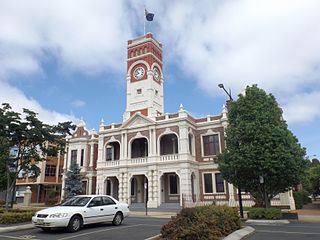
Toowoomba City Hall is a heritage-listed town hall at 541 Ruthven Street, Toowoomba, Toowoomba Region, Queensland, Australia. It was designed by Willoughby Powell and built in 1900 by Alexander Mayne. It is also known as Toowoomba Town Hall. It was added to the Queensland Heritage Register on 21 October 1992.

Wetherby Town Hall is a community building in Wetherby, West Yorkshire, England. The town hall no longer plays a major civic function but provides an office which is used by Wetherby Town Council and facilities for local groups and events. It is a Grade II listed building.

The Bank of New South Wales is a heritage-listed former bank at 242 Mary Street, Gympie, Gympie Region, Queensland, Australia. It was designed by Richard Gailey and built from 1890 to 1891 by T. Kelly. It is also known as Widgee Shire Council Chambers, Coolooa Shire Council Chambers and Gympie Regional Council Chambers. It was added to the Queensland Heritage Register on 15 April 2011.
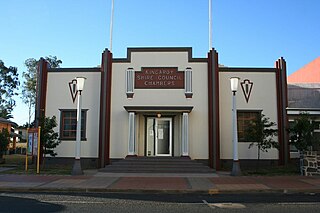
Kingaroy Shire Council Chambers is a heritage-listed former town hall and now visitor information centre and art gallery at Haly Street, Kingaroy, South Burnett Region, Queensland, Australia. It was designed by Gerard William Barlow and built in 1938 by Kell & Rigby. It was added to the Queensland Heritage Register on 9 November 2012.

Newcastle Post Office is a heritage-listed former post office at 96 Hunter Street, Newcastle, City of Newcastle, New South Wales, Australia. It was designed by Walter Liberty Vernon in his capacity as New South Wales Government Architect and was built from 1900 to 1903 by R. Saunders (freestone), Loveridge & Hudson (trachyte), Mountney & Co., Chas Dobson & Co. and J. P. Woods. It was added to the New South Wales State Heritage Register on 22 December 2000.

Forbes Post Office is a heritage-listed post office at 118 Lachlan Street, Forbes, Forbes Shire, New South Wales, Australia. It was designed by the New South Wales Colonial Architect's Office under James Barnet and built from 1879 to 1881 by P. M. Vaughan. The property is owned by Australia Post. It was added to the New South Wales State Heritage Register on 22 December 2000. It was added to the Australian Commonwealth Heritage List on 22 June 2004.
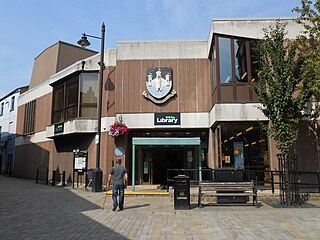
Pontefract Library is a public library in Pontefract, West Yorkshire, England. The present day building is notable as one of the last examples of architecture by John Poulson
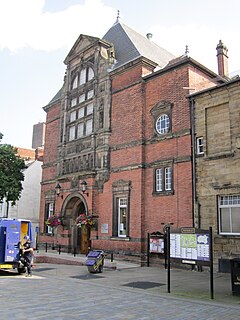
Pontefract Town Hall is a town hall in Pontefract, West Yorkshire, England. It was completed in 1882. It is now owned and used by Wakefield Council as a registry office. The building has been Grade II listed since 15 November 1988.
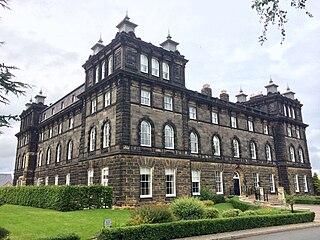
Wells House is a large former hydropathic establishment and hotel in Ilkley, West Yorkshire, England, now used as private apartments. It was built in 1854–56 to a design by the architect Cuthbert Brodrick and is a Grade II listed building. It is located above the town on Wells Road at the edge of Ilkley Moor, giving it an unobstructed view across Wharfedale from its north front. It was originally set in grounds by the landscaper Joshua Major though these gardens have mostly been built on since.

Scarborough Town Hall, originally St Nicholas House, is a red brick Jacobean Revival mansion in Scarborough, North Yorkshire, England, currently used as a municipal building for the Borough of Scarborough and an events venue. It was built in the 19th century as a home for John Woodall, a prominent local businessman, and then converted and extended for municipal use in 1903. Situated overlooking the South Bay, it is a grade II listed building.

Wakefield Town Hall is a municipal building in Wood Street in Wakefield, West Yorkshire, England. It remains a venue for weddings and civil partnerships but is no longer the headquarters of Wakefield Council which is now based at County Hall. The town hall is a Grade I listed building.

Rotherham Town Hall is a municipal building in The Crofts, off Moorgate Street in Rotherham, South Yorkshire, England.

Otley Civic Centre is a municipal structure in Cross Green, Otley, West Yorkshire, England. The structure, which was the offices and meeting place of Otley Town Council, is a Grade II listed building.





















